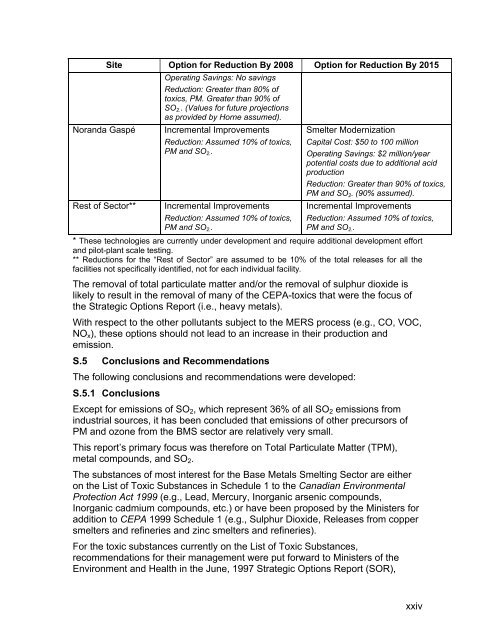(MERAF) for the Base Metals Smelting Sector - CCME
(MERAF) for the Base Metals Smelting Sector - CCME
(MERAF) for the Base Metals Smelting Sector - CCME
Create successful ePaper yourself
Turn your PDF publications into a flip-book with our unique Google optimized e-Paper software.
Noranda Gaspé<br />
Rest of <strong>Sector</strong>**<br />
Site Option <strong>for</strong> Reduction By 2008 Option <strong>for</strong> Reduction By 2015<br />
Operating Savings: No savings<br />
Reduction: Greater than 80% of<br />
toxics, PM. Greater than 90% of<br />
SO 2. . (Values <strong>for</strong> future projections<br />
as provided by Horne assumed).<br />
Incremental Improvements<br />
Reduction: Assumed 10% of toxics,<br />
PM and SO 2. .<br />
Incremental Improvements<br />
Reduction: Assumed 10% of toxics,<br />
PM and SO 2. .<br />
Smelter Modernization<br />
Capital Cost: $50 to 100 million<br />
Operating Savings: $2 million/year<br />
potential costs due to additional acid<br />
production<br />
Reduction: Greater than 90% of toxics,<br />
PM and SO 2 . (90% assumed).<br />
Incremental Improvements<br />
Reduction: Assumed 10% of toxics,<br />
PM and SO 2. .<br />
* These technologies are currently under development and require additional development ef<strong>for</strong>t<br />
and pilot-plant scale testing.<br />
** Reductions <strong>for</strong> <strong>the</strong> “Rest of <strong>Sector</strong>” are assumed to be 10% of <strong>the</strong> total releases <strong>for</strong> all <strong>the</strong><br />
facilities not specifically identified, not <strong>for</strong> each individual facility.<br />
The removal of total particulate matter and/or <strong>the</strong> removal of sulphur dioxide is<br />
likely to result in <strong>the</strong> removal of many of <strong>the</strong> CEPA-toxics that were <strong>the</strong> focus of<br />
<strong>the</strong> Strategic Options Report (i.e., heavy metals).<br />
With respect to <strong>the</strong> o<strong>the</strong>r pollutants subject to <strong>the</strong> MERS process (e.g., CO, VOC,<br />
NO x ), <strong>the</strong>se options should not lead to an increase in <strong>the</strong>ir production and<br />
emission.<br />
S.5 Conclusions and Recommendations<br />
The following conclusions and recommendations were developed:<br />
S.5.1 Conclusions<br />
Except <strong>for</strong> emissions of SO 2 , which represent 36% of all SO 2 emissions from<br />
industrial sources, it has been concluded that emissions of o<strong>the</strong>r precursors of<br />
PM and ozone from <strong>the</strong> BMS sector are relatively very small.<br />
This report’s primary focus was <strong>the</strong>re<strong>for</strong>e on Total Particulate Matter (TPM),<br />
metal compounds, and SO 2 .<br />
The substances of most interest <strong>for</strong> <strong>the</strong> <strong>Base</strong> <strong>Metals</strong> <strong>Smelting</strong> <strong>Sector</strong> are ei<strong>the</strong>r<br />
on <strong>the</strong> List of Toxic Substances in Schedule 1 to <strong>the</strong> Canadian Environmental<br />
Protection Act 1999 (e.g., Lead, Mercury, Inorganic arsenic compounds,<br />
Inorganic cadmium compounds, etc.) or have been proposed by <strong>the</strong> Ministers <strong>for</strong><br />
addition to CEPA 1999 Schedule 1 (e.g., Sulphur Dioxide, Releases from copper<br />
smelters and refineries and zinc smelters and refineries).<br />
For <strong>the</strong> toxic substances currently on <strong>the</strong> List of Toxic Substances,<br />
recommendations <strong>for</strong> <strong>the</strong>ir management were put <strong>for</strong>ward to Ministers of <strong>the</strong><br />
Environment and Health in <strong>the</strong> June, 1997 Strategic Options Report (SOR),<br />
xxiv
















